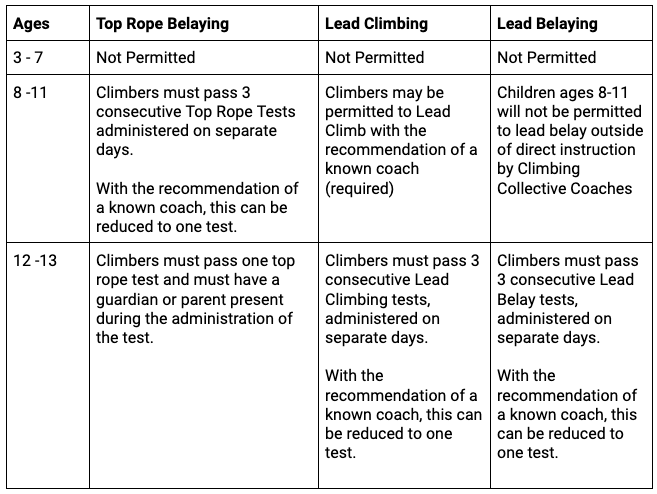Climbing Collective Guidelines
Climbing at the Collective is an exciting and rewarding experience, and to ensure the safety and enjoyment of all members, we have established the following guidelines.
Climbing is a technical sport that demands training, knowledge, and discipline. It's essential for climbers to recognize the inherent risks, assume personal responsibility for safety, and commit to sound climbing practices. Whether climbing indoors or outdoors, the following safety principles are paramount:
Inherent Risks: Climbing can never be entirely risk-free. Like any sport, the potential for accidents or injuries exists. Acknowledge and understand this inherent risk.
Personal Risk Tolerance: Each climber must assess and determine their own level of risk tolerance. Recognize that this is a personal decision that varies from individual to individual.
Training and Discipline: Through training and personal discipline, individuals can significantly reduce their risk levels. Invest time and effort in learning proper climbing and belaying techniques.
Risk Reduction: Diligently following established safety protocols helps in minimizing risks not only for oneself but also for fellow climbers. Regularly practicing proper climbing and belaying techniques is crucial.
Avoid Complacency: Discipline is key to avoiding complacency. Stay vigilant and avoid becoming overly comfortable. Consistently perform double-checks on equipment, tie-ins, and communications.
Personal Responsibility: Climbers must actively assume personal responsibility for their actions. This includes checking personal equipment and ensuring the safety of climbing partners.
Equipment Checks: Always check your equipment and that of your climbing partner before each climb. Regular maintenance and inspection contribute to a safe climbing environment.
Experienced Climbers: Experienced climbers play a crucial role in fostering a safe climbing culture. Encourage others to follow safety protocols and offer assistance when needed, especially to those new to the sport.
By adhering to these safety guidelines, climbers contribute to a safer and more enjoyable climbing experience for themselves and the climbing community as a whole. Safety is a shared responsibility that requires a commitment from every individual in the climbing community.
For full details about our expectations, guidelines and your responsibilities, please refer to our waiver at https://climbingcollective.co/waiver
Rules & Guidelines
-
For the safety and enjoyment of all, we kindly request visitors to adhere to the following guidelines when at Climbing Collective:
Registration and Agreement: All visitors must register at the front desk and complete the Climbing Collective waiver before participating in any activities.
Child Supervision: Parents are responsible for their children at all times. Children under 14 must be supervised unless part of a Climbing Collective program.
No Running or Horseplay: Please refrain from running, horseplay, or any form of gymnastics. Avoid swinging on the ropes to maintain a safe environment.
Respectful Behavior: Maintain a positive atmosphere by avoiding yelling or the use of profanity within the facility.
Food and Drink: With the exception of water, food and other drinks are not permitted in the climbing area. Please use the designated areas for consuming snacks or beverages.
Gear Storage: Keep all clothing, equipment, and water bottles off padded areas. Lockers and cubbies are provided throughout the gym for your convenience.
No Smoking or Substance Use: Smoking, drugs, and alcohol are strictly prohibited. Anyone suspected of being under the influence may be asked to leave the premises.
Footwear in Bathrooms: For hygiene and safety reasons, climbing shoes are not allowed in the bathrooms. Please remove them before entering.
We appreciate your cooperation in maintaining a safe and welcoming environment for all Climbing Collective visitors. If you have any questions or require assistance, our staff at the front desk will be happy to help.
-
To ensure a secure and enjoyable climbing experience for everyone, please adhere to the following guidelines while at Climbing Collective:
Belaying Requirements:
Climbers with hands above 12' must be "on-belay" unless in designated bouldering areas.
All belayers (top rope and lead) must pass a Climbing Collective belay qualification test. Specific restrictions apply for belayers under the age of 14. Refer to our Youth Belay Policies for details.
Belay Devices:
Most standard belay devices are allowed for top rope belay (ATCs, GriGris, etc.).
Figure 8 devices are not allowed for belaying in our facility.
Seek instruction from Climbing Collective staff before using unfamiliar equipment.
Bouldering Safety:
Climbers voluntarily participating in bouldering acknowledge its inherent dangers. Bouldering carries a higher injury risk due to ground falls; neither spotters nor padded flooring can prevent injuries.
Training Area Restrictions:
The fitness / training area is reserved for climbers aged 14 and above or those with approval from a Climbing Collective climbing coach or if accompanied by an adult.
Awareness and Etiquette:
Be vigilant of your surroundings; do not climb, stand, or sit below another climber.
Climbing with headphones is not permitted.
Prohibited Activities:
Climbing on anything besides designated surfaces (e.g., ladders, building structures) is strictly prohibited.
Instructional Policies:
Only Climbing Collective staff may provide lead-climbing instruction.
Please register for one of our many climbing classes to receive your climbing instruction.
Lead Climbing Responsibilities:
Lead climbers who utilize their own rope and ensure it is in good condition and of appropriate length (40M ropes required) for lowering to the ground.
Your cooperation in adhering to these guidelines contributes to a safe and enjoyable climbing environment for all. If you have questions or require assistance, please approach a Climbing Collective staff member.
-
Climbers are required to successfully complete a Climbing Collective Top Rope Belay test, showcasing the essential skills required for effective belaying. Lead Climbers must pass tests for both lead climbing and lead belaying, and these assessments must be conducted with a partner. For those intending to use auto-belays, a Climbing Collective staff member will provide an orientation.
-
As you reach the finish hold, try to descend by climbing back down
Avoid attempting to catch yourself with your arms during a fall.
Refrain from trying to “stick” your landing; instead, roll with your momentum to minimize impact.
Using a spotter is not recommended, as spotters understand the potential risk of injury when assisting a climber during a fall.
-
Be mindful of other climbers in highly trafficked areas, on routes that intersect, or in zones with intersecting fall paths. Take turns accordingly.
Exercise courtesy on auto-belays; yield to others waiting in line and avoid continuous laps if there's a queue.
The climber who starts their climb first has the right-of-way on the climbing wall.
While it's natural to want to share ideas or offer advice (beta), consider asking if the climber would like to receive guidance. Respect their preference for problem-solving or assistance.
For bouldering, place chalk bags and buckets on the ground to avoid fall zones. Dust your hands inside a chalk bag or bucket to contain excess chalk.
If using a brush pole, store it in a safe, landing-zone-free space, preferably in designated holders.
Keep climbing shoes off restroom floors to maintain cleanliness and consideration for fellow climbers.
Youth Belay & Lead Climbing Policy
Belaying and Lead Climbing demand careful attention and skill. We've defined a set of guidelines for youth under 14 concerning qualifications for belaying and lead climbing. Those involved in youth clubs or Climbing Collective Team may be authorized to engage in belaying and lead climbing within the program, provided they exhibit the necessary competence and attentiveness.
For youth under 14, a parent or guardian MUST be present during the administration of any Top Rope Belay, Lead Climb, or Lead Belay test.
A child under the age of 14 who is Top Rope Belaying, Lead Climbing, or Lead Belaying MUST be directly supervised at all times by an adult who holds an equal or greater level of certification. Direct supervision is defined as on the ground, within sight and sound of the youth belayer/climber.
All children under the age of 14 MUST use an assisted-braking belay device, such as the following:
Petzl GriGri 1, 2, or Plus
Edelrid MegaJul, MegaJul Sport, Jul 2, or Eddy
Black Diamond ATC Pilot
Mad Rock Lifeguard
Trango Vergo or Cinch
Climb Tech ClickUp or ClickUp +
Mammut Smart or Smart 2.0
Youth qualifications for Top Rope Belay, Lead Climb, and Lead Belay may be revoked at any time, by any Climbing Collective staff member.
Failure to adhere to perfect technique and safety protocols will result in revocation.
Failure to adhere to gym policies will result in revocation.
Revoked youth qualifications may be reinstated following the policies outlined above.

